 |
In Anatolia there are signs of human habitation in caves from at least the stone age. there are also rock paintings and engravings of people and animals on the walls of these caves, such as those near Antalya and elsewhere.
 |
Gobekli Tepe
To date, the most astonishing find is at Göbekli Tepe (Turkish for "Hill with a Tummy"), which is a hilltop sanctuary built on the highest point of an elongated mountain ridge about 15km northeast of the town of Şanlıurfa (Urfa) in southeast Turkey. This site, currently undergoing excavation by German and Turkish archaeologists, is said to have been erected by hunter-gatherers at perhaps 11,500 B.C. This is believed to be before the advent of sedentism (permanent year-round settlement). That claim however, does not seem logical. Note the finely carved pillars to support the roof, it doesn't seem like Hunter Gatherer Nomads would have acquired the skills to do such work. What use would Hunter Gatherer Nomads have for such a structure? Hunter Gatherer Nomads did not store food, they moved to find food, how would Hunter Gatherer Nomads feed themselves while building the site? In any event, it is currently considered the oldest known shrine or temple complex in the world. And the planet's oldest known example of monumental architecture.
Together with the site of Nevalı Çori, (which has since been inundated by the waters of a Dam across the Euphrates), it has revolutionized our understanding of the Anatolian stone age. At the oldest level, the buildings at Göbekli Tepe contain monolithic “T” shaped pillars, which link coarsely built walls, which form circular or oval buildings. So far four such buildings, with diameters between 33 ft. and 100 ft. have been uncovered. Geophysical studies suggest 16 more structures exist there.
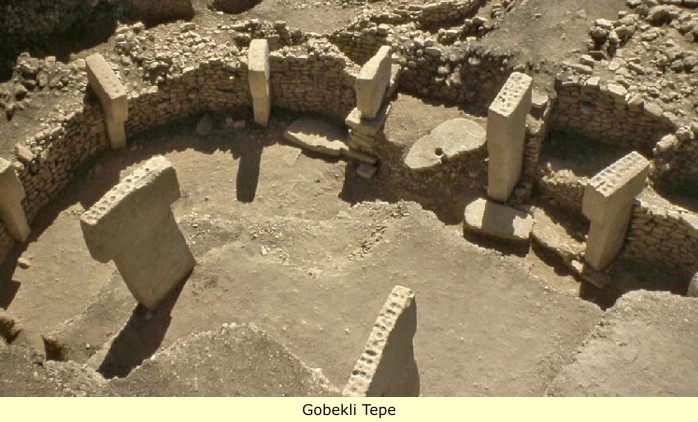 |
The later Stratum II, dated to Pre-Pottery Neolithic B period (7,500 - 6,000 B.C.), revealed houses or temples that are round megalithic (large stone) buildings . The walls are made of unworked dry stone and include numerous T-shaped monolithic pillars of limestone that are up to 10 ft. high. Another bigger pair of pillars is placed in the center of the structure. The floors are made of terrazzo (burnt lime), and there is a low Bench running along the whole of the outside wall. The relief’s (carvings) on the pillars include foxes, lions, cattle, wild boars, herons, ducks, scorpions, ants and snakes. Some of the relief’s had been deliberately erased, maybe in preparation for new pictures. There are freestanding sculptures as well, that may represent wild boars or foxes. Comparable statues have been discovered in Nevalı Çori and Nahal Hemar.

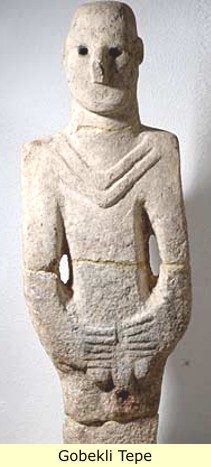
Nevali Cori
At Nevali Cori, the local limestone was carved into numerous statues and stele, including a more than life-sized bare human head with a snake or sikha-like tuft, (sikha- a long tuft, or lock of hair left on top or on the back of the shaven head). There is also a statue of a bird. Some of the pillars also have carved relief's, including human hands. The free-standing anthropomorphic figures (attribution of human characteristics to non-human creatures), which are made of limestone, are Comparable to sculptures found at Göbekli Tepe; together they are the oldest known life-sized sculptures.
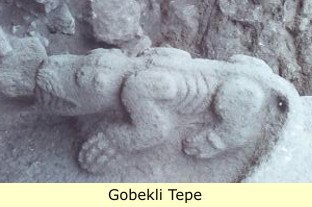
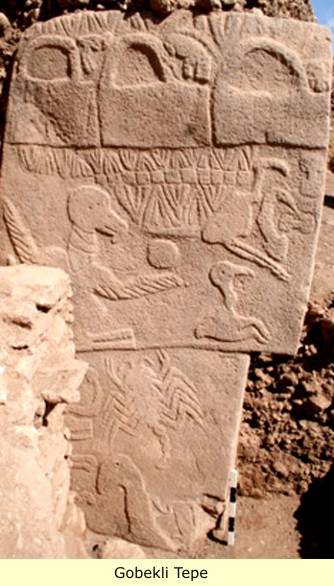

Also found at Nevali Cori, (pictures have not been released), were several hundred small clay figurines (about 2 in. high), most of them depicting humans, these have been interpreted as votive offerings. These figures were fired at temperatures between 500-600° C, which suggests the development of ceramic technology before the advent of pottery proper.
 |
Mythological considerations
The excavator of the site, Klaus Schmidt, has engaged in some speculation regarding the belief systems of the people that created Göbekli Tepe. Based on comparisons with other shrines and settlements, he assumes that they had shamanic practices, and suggests that the T-shaped pillars may represent mythical creatures, perhaps ancestors. Whereas he sees a fully articulated belief in gods, only developing later in Mesopotamia, which has the associated extensive temples and palaces.
The excavator of the site, Klaus Schmidt, has engaged in some speculation regarding the belief systems of the people that created Göbekli Tepe. Based on comparisons with other shrines and settlements, he assumes that they had shamanic practices, and suggests that the T-shaped pillars may represent mythical creatures, perhaps ancestors. Whereas he sees a fully articulated belief in gods, only developing later in Mesopotamia, which has the associated extensive temples and palaces.
This corresponds with the old Sumerian belief that agriculture, animal husbandry and weaving had been brought to humankind from the sacred mountain of Duku (Dulkug), which was inhabited by Annuna-deities, which were very ancient gods without individual names. Klaus Schmidt identifies this story as a primeval myth that preserves a partial memory of the Neolithic. It is also apparent that the animal and other images are peaceful in character and give no indications of organized violence.
| Interestingly; the complex was not gradually abandoned and simply forgotten. Instead, it was deliberately covered over with soil. The builders obviously wanted it preserved for posterity. |

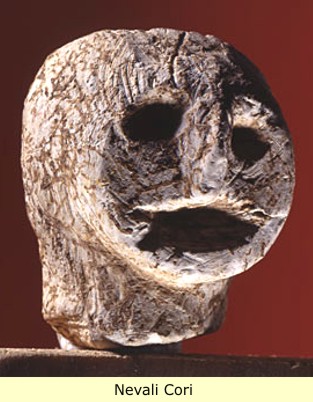
Lake Burdur
Other Sites like Hacilar near Lake Burdur, have some of the earliest actual settlements, these from about 8,000 B.C. The people here were living in mud-brick houses with plastered walls and floors. Their homes were painted and burnished, like those in contemporary Jericho in Canaan. These earliest settlements were characterized by the planting of barley and sometimes wheat. But they produced no pottery, and the only domestic animal was the dog.
Afterward, the site seems to have been abandoned for nearly a thousand years. But was then re-occupied in the late phase of the Stone Age, by villagers of a far more sophisticated culture. These people had advanced agriculture and pottery. Their houses were symmetrically arranged, and these people produced human-looking and large sized, fertility and goddess figures.
Catal Huyuk
At the site of Çatal hüyük, there is evidence of a town that was occupied from about 7,500 B.C. Here apart from extensive evidence of the obsidian tool industry, we also find an early form of metallurgy. Lead and copper were shaped into ornaments like pendants, beads, rings and small utilitarian tools. Like at Lake Burdur, we find houses with very elaborate architectural features in each space; like wall paintings, platforms, and cult spaces. The small family houses are knitted together with no streets, occasional open spaces between the buildings were used as garbage disposal areas. The houses had their entrances through a hole in the roof, which was accessed by a ladder. The hearth and the oven were placed directly below this hole in the roof, so that the hole in the roof also acted as the chimney for the house.The housetops were mud-plastered terraces, which also acted as the communal outdoor space for the family. The houses were mostly of the same size and arrangement; each house had a rectangular room with a narrow storage space or a compartmentalized space along one side. The large rectangular living room would also have a built-in platform, used for a variety of activities in the house. The houses were built of a timber frame of posts and beams, which divided the walls into a series of horizontal and vertical panels, which were then filled with mudbrick and plastered over. Though the houses are built one against each other, they almost never share walls; each room has its own walls independent of the adjoining structure.
 |
 |
Another painted scene is of large stylized vulture-like birds depicted with small headless human beings; this is interpreted as a funerary ritual. When people died in Catal Huyuk they took the body out of the settlement and left it out in the open for birds to consume the flesh: and only after that, the bones were brought back to the house and buried under the platforms. [This is the exact funerary practice of later Persians in Elam, and Hebrews in Canaan, see below].
One of the most significant aspects of Çatal Huyük houses is the practice of burial under the floor of living spaces, usually with elaborate grave goods and sometimes, organic materials. At times, the burials are so intense that in one building, a total of 67 individuals were buried under one room, in a space of less than 30 square meters. Many fertility goddess figurines were also found, made of clay, and very fragile, (fired at low temperature), representing an obese female with exaggerated sexual organs: some depicted in the state of giving birth and accompanied by lions.
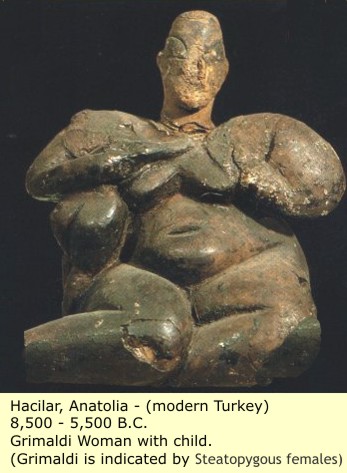
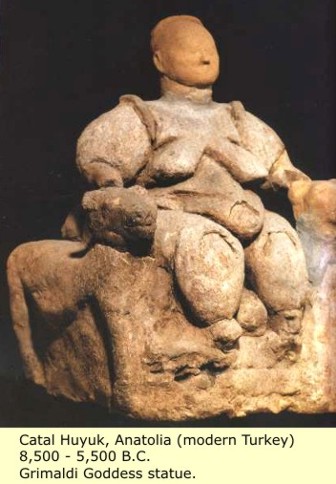
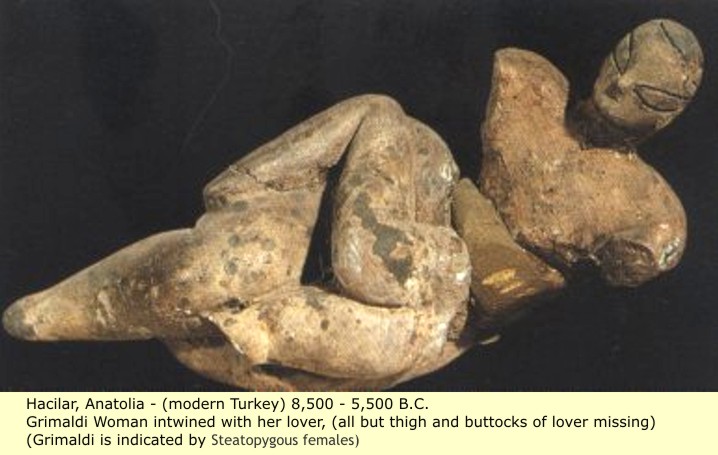 |
Ancestral Relationship between the Khoisan Grimaldi of Anatolia and the Hebrews and Persians.

The ancient Anatolian Burial Practice of de-fleshing the body, and then placing the bones in a container for burial: is unique and practiced by only two later cultures. Principal among them are the Persians of the Zoroastrian religion. Their practice was to place the body where it may be eaten by scavenging birds and animals or weathered to its bare bones, and then placed in a container for burial.
In Bombay India, the Parsis (as the Indian descendants of the Persian refugees from the Arab/Turk invasion are called) maintain “towers of silence” which are high circular towers. The dead are carried to the top, and funeral servants place them on stone beds surrounding a central pit. After the hovering vultures have stripped the flesh from the bones, the bones are gathered and placed into the central pit.
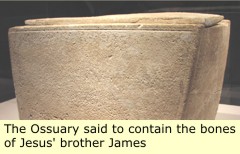 The Hebrews - Around two thousand years ago, during the time that Jesus Christ lived, Hebrew burial tradition shifted to include a secondary burial in Ossuaries. This burial practice involved collecting the deceased’s bones after the flesh had been left to decompose and desiccate, and then placing them inside an Ossuary. The Ossuary was then placed into a loculus – a type of satchel.
The Hebrews - Around two thousand years ago, during the time that Jesus Christ lived, Hebrew burial tradition shifted to include a secondary burial in Ossuaries. This burial practice involved collecting the deceased’s bones after the flesh had been left to decompose and desiccate, and then placing them inside an Ossuary. The Ossuary was then placed into a loculus – a type of satchel.These precise burial practices are unique to those mentioned people, and to no other people of the world. Logically then, the question must be asked: are they related? It is no stretch to connect the Hebrews with these ancient Anatolians: From the time of the less ancient Sumerians, the Hebrews (formally called Amorites), were known to be a nomadic people inhabiting the area formed by the conjunction of the borders of modern day Turkey, Syria, and Iraq. The Bible suggests that the city of Harran (which is in the center of that area) is in the homeland of the Hebrews, and referrers to it by name.
"And Terah took Abram his son, and Lot the son of Haran his son's son, and Sarai his daughter in law, his son Abram's wife; and they went forth with them from Ur of the Chaldees, to go into the land of Canaan; and they came unto Harran, and dwelt there".
No comments:
Post a Comment